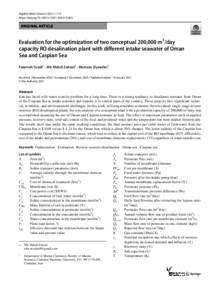Document
Evaluation for the optimization of two conceptual 200,000 m3/day capacity RO desalination plant with different intake seawater of Oman Sea and Caspian Sea.
Identifier
DOI: 10.1007/s13201-020-01338-5
Source
Applied Water Science. v. 11, 2, 12
Contributors
Zahedi, Mir Mahdi., Author
Ziyaadini, Morteza., Author
Country
Germany.
City
Berlin
Publisher
Springer Science and Business Media Deutschland GmbH.
Gregorian
2021-02-01
Language
English
English abstract
Iran has faced with water scarcity problem for a long time. There is a strong tendency to desalinate seawater from Oman or the Caspian Sea as intake seawater and transfer it to central parts of the country. These projects face significant technical, economic, and environmental challenges. In this work, utilizing available economic theories about single-stage reverse osmosis (RO) desalination plants, the cost analysis of a conceptual plant with a production capacity of 200,000 m3/day, was accomplished assuming the use of Oman and Caspian seawater as feed. The effect of important parameters such as applied pressure, recovery ratio, total salt content of the feed, and produced water and the temperature has been studied theoretically. The results show that under the same working conditions, the final product price per cubic meter of freshwater from the Caspian Sea is $ 0.69 versus $ 1.24 for the Oman Sea, which is about 50% cheaper. The lower salinity of the Caspian Sea compared to the Oman Sea is the main reason, which lead to reduce in the capital cost of the RO membrane (62% difference), cost of the intake and pretreatment (20%), and cost of membrane elements replacement (13%) regardless of water transfer cost.
ISSN
2190-5487
Resource URL
Category
Journal articles

